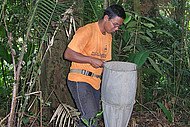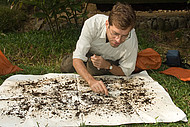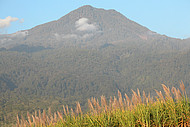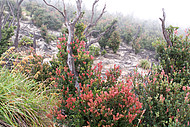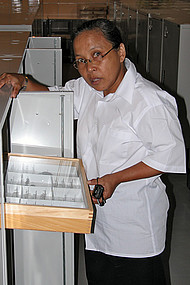Biodiversity of leaf litter inhabiting arthropods of natural forests in Java
Java is the most densely populated island of Indonesia with about 127 million inhabitants. So, it can not be a surprise that wide areas have been deforested and converted into agricultural land. However, many of the mountains and some areas of lowland retained their natural vegetation of tropical rainforest. Some of these areas are designated National Parks, others are simply Protected Forests.
While the native fauna of birds and mammals is relatively well-know, the taxonomy of Javanese arthropods is still at an early stage. For most of the taxa there exist no comprehensive handbooks that could be used for identification. The majority of leaf litter arthropods of Java are still undescribed, i.e. they do not possess a scientific name and they can not be referred to in the literature. Also, the material of South East Asian soil arthropods available in museum collections is generally scarce. Soil arthropods can hardly be collected “by accident” as some other groups of insects, but samples need to be sifted and specimens need to be extracted using various techniques.
In 2005 A.Riedel started a successful collaboration with Prof. Dr. Yayuk R. Suhardjono, Cahyo Rahmadi and Hari Nugroho of the Zoological Museum Bogor, the most important zoological museum in Indonesia. On joint collecting trips in 2005, 2006, and 2010 several localities of primary forest in Java were sampled for the first time. A high proportion of leaf litter inhabiting arthropods are flightless and thus they are highly restricted in their means of dispersal. Many are endemic to small areas, such as an individual mountain.
The purpose of the project is to obtain samples of leaf litter inhabiting arthropods from as many localities in Java as possible. Based on this material selected taxonomic groups will be revised. A.Riedel is working on Curculionidae, Y.R.Suhardjono on Collembola, C.Rahmadi on the Opilionid genus Stylocellus. Many new species will be scientifically described for the first time. Based on these data, distribution patterns can be analysed. It will be possible to identify areas that are especially rich in endemic species. The factors responsible for the local differences in diversity will be examined. Java is part of the Sunda volcanic arc and is mainly of volcanic origin. The influence of the volcanic history on biodiversity patterns will be examined.
Finally, it will be possible to provide a priority list for conservation. Areas of high arthropod biodiversity should be ranked higher compared to areas with lower diversity, granted that there is no conflict with the diversity of other taxa (such as plants or vertebrates). Based on the preliminary data Gn. Sawal could be such a high priority area; unfortunately, its conservation status is at present relatively low. Flagship species for conservation are disappearing / have disappeared, such as the Java tiger that has become extinct in the last century. It is hoped that lists of endemic arthropods can somewhat compensate this loss and that the value of natural forests can still be justified in front of politicians and the public.
The project was funded by DFG project RI 1817/1-1, and is currently funded in part by grant RI 1817/3-1 from the German Research Foundation (DFG).
Selected Publications
- Riedel A., Tänzler R., Balke M., Rahmadi C., Suhardjono Y.R. (2014):
- Ninety-eight new species of Trigonopterus weevils from Sundaland and the Lesser Sunda Islands. ZooKeys 467: 1-162

Dr. Alexander Riedel, Dipl.-Biol.
Phone: +49 721 175-2836
E-Mail: riedel@smnk.de





